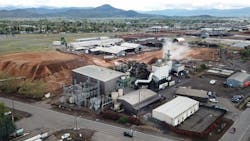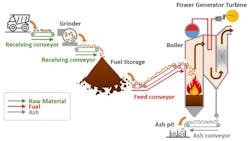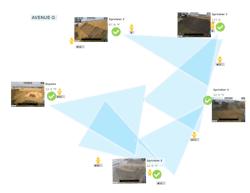Biomass One Prevents Wood Pile Fires with Thermal Imaging Solution
Biomass One (White City, OR, USA), produces electricity using wood waste that otherwise would rot in landfills or forests. But the wood, which ages in a huge pile, can catch on fire in hot weather, spewing smoke, and sometimes spreading to a nearby business.
However, the situation changed dramatically in 2022 when Biomass One installed an automated early-warning system based on thermal imaging. Since then, the fire department has not been called to put out a single fire on the company's property.
“We’re a wood-fired power plant, and so we have two wood fired boilers and two steam turbines. We sell to the local utility,” Pacific Power (Portland, OR, USA), explains Ryan Burns, operations superintendent at Biomass One. “We burn about 20,000 tons a month,” he says, adding that pollution control systems on the boilers minimize the impact on local air quality.
Sourcing and Preparing Wood Fuel
Biomass One encourages the public to drop off wood waste, which the company chips and ages in a pile before moving it into the electricity-making process. The company also buys debris from local mills and works with the local forest service to remove slash piles, or wood debris left behind by loggers.
Related: Machine Vision System Detects Forest Fires Early, Aiding Efforts to Extinguish Them
Biomass One keeps enough wood fuel on-site to sustain its electricity producing operations for three or four months. There are two piles: One open to the public for debris drop off and a second storage pile across the street, measuring about 800 (w) x 800 (l) x 45 (h) ft, or about eight acres. Employees move the wood from the drop-off pile to storage pile using an over-the-road conveyor.
Biomass One typically has about 80,000 tons of wood debris stored in the pile.
While the surface of the storage pile may be the same as the outdoor temperature, internal layers get much hotter. “As they get compacted and they start to degrade, you have this naturally occurring increase in temperature. And if that temperature isn’t allowed to escape, because you have compacted materials, that's when you start to have issues with smoldering combustion and fire,” explains David Bursell, vice president of development at MoviTHERM (Irvine, CA, USA), the developer of the automated early-warning system in place at Biomass One.
Related: How Metal Recycling Facilities Use IoT and Thermal Imaging to Improve Early-Warning Fire Detection
Ineffective Manual Fire Prevention
Before installing the MoviTHERM system, Biomass One relied on manual preventive measures. During the six hottest months of the year, the company hired temporary employees, and they would stand watch over a section of the pile, looking for signs of a fire. “We’d have eyes on every side of the pile,” Burns says.
They hired enough people to cover the entire pile 24/7 at a cost of $250,000 annually in wages.
If the fire watchers detected signs of combustion, they would notify an employee inside a central control room who could take corrective action, such as activating water cannons installed on top of 65-ft poles and located strategically around the pile.
But hiring and keeping temporary employees engaged in such a boring job was challenging. “People sleep. People call in sick,” recalls Toby Sakraida, electrical and fire suppression engineer at the facility. Fires were often missed until it was too late to stop them without help from the fire department, which, fortunately, is in the same industrial park.
Related: Thermal Ranging Technique Delivers Detailed Images
Installing an Automated IoT Thermal Imaging Solution
Sakraida, who was hired four years ago, began investigating other solutions soon after he joined the team, starting with hand-held thermal cameras that fire watchers used to check for hot spots.
Thermal cameras sense infrared radiation, or heat, emitted by objects. They report this information as an image of a scene that displays temperature differences. “As a fire develops, the temperature of the surrounding materials increases. This generates a heat signature that can be detected by infrared cameras. This heat signature can be an early indication of a fire’s presence, even before smoke is visible,” MoviTHERM explains on its website.
However, Sakraida was not happy with the hand-held thermal cameras because they were still part of a hit-or-miss manual operation.
Related: Thermal Imaging Aids Wildlife Conservation Efforts
After researching possible solutions online, he found the automated solution from MoviTHERM. Called MoviTHERM iEFD, the solution detects hot spots in businesses prone to spontaneous fires. This includes laundries, metal recycling operations, and biomass facilities. The solution combines thermal smart cameras with proprietary gateway hardware and cloud-based software for monitoring, alert notification, and trend analysis.
MoviTHERM iEFD is designed to be an event-based system. It allows users to set temperature thresholds for alerts, which can be sent via email, voicemail, or text. Once employees have remedied the threat, users get a second alert to let them know that problem has been solved.
How the Thermal Imaging System Works
The system at Biomass comprises five Teledyne FLIR (Wilsonville, OR, USA) A700 cameras, installed with brackets on the same metal poles as the water cannons. Because they are outside in all sorts of weather, each camera is enclosed in IP66-rated metal housing—the Megalodon from autoVimation (Rheinstetten, Germany). A sixth camera, with RGB capabilities, provides a view of the entire pile, feeding images to a computer and monitor set up in Biomass One’s control room.
The MoviTHERM system is designed to detect hot spots early—before smoke and fire occur. The process starts with the fixed-mount A700 Smart Sensor cameras, which have a sensor resolution of 640 x 480, providing a total of 307,200 pixels of temperature readings. The camera detects temperatures ranging from -20° C to 2000° C.
To transmit data from the thermal imaging cameras to MoviTHERM’s cloud-based software, the system uses a proprietary gateway, set up in Biomass One’s control room. The gateway utilizes the Modbus industrial protocol to communicate with the cameras and Power over Ethernet (PoE) via a wireless network to communicate with the cloud infrastructure.
Transmission occurs over buried fiber optic cables running from each pole to the control room with distances of up to 1,800 ft. Ethernet cables connect the cameras to the fiber.
Image processing occurs on the camera, which reports the maximum temperature within a user-selected region of interest. Users can select up to 10 regions of interest per camera. “So, the camera is doing this filtering, if you will, or screening, looking for the maximum temperature,” explains Bursell. “That’s the temperature that we see at the gateway.”
The gateway further filters the information, sending the highest reading for each camera to the cloud-based software. Those readings are stored for three months and available for officials at Biomass One or the fire department to review using a web-based dashboard.
Biomass One typically sets up one large region of interest per camera but sometimes will also set up two or three smaller areas, Sakraida says. “This allows us to monitor hot spots that are in the camera frame but are not part of the general region,” he explains.
If the temperature reported by one of the five cameras reaches a threshold of 260° F, as set by Biomass, MoviTHERM’s system triggers an alarm in the control room, prompting corrective action, such as sending an employee to check out the area or triggering the water cannons. Text messages also are sent from the cloud infrastructure to the mobile phones of Burns and Sakraida.
Setting the temperature threshold is a balancing act, Sakraida notes. The team wants to know if temperatures in the pile are at risk of becoming dangerous, but they don’t want to set the threshold so low that they receive nuisance alarms. Fire occurs at 1700° F.
Results of Machine Vision Monitoring System
As mentioned earlier, the fire department hasn’t put out a fire since Biomass One installed the MoviTHERM system. With the manual process, fires erupted weekly during the hot months of the year, Burns recalls.
Biomass officials are pleased with the results, and so are fire officials, says Sakraida and Burns.
During Sakraida’s first year on the job, fire officials “were out constantly, driving around, checking on us.” After the new system was installed, “they kind of started slacking off.” Now, it’s rare to see fire officials drive by.
Part of the reason may be that they also have access to the cloud-based system and receive the alerts. “They can check up on it without having to come down all the time,” Sakraida notes.
Summing up the impact of the thermal imaging system in a video MoviTHERM created, Burns says, “This has allowed us all to have a little better home life, I would say. And at work, we are able to focus on the job at hand instead of babysitting a fuel pile.”
About the Author
Linda Wilson
Editor in Chief
Linda Wilson joined the team at Vision Systems Design in 2022. She has more than 25 years of experience in B2B publishing and has written for numerous publications, including Modern Healthcare, InformationWeek, Computerworld, Health Data Management, and many others. Before joining VSD, she was the senior editor at Medical Laboratory Observer, a sister publication to VSD.




